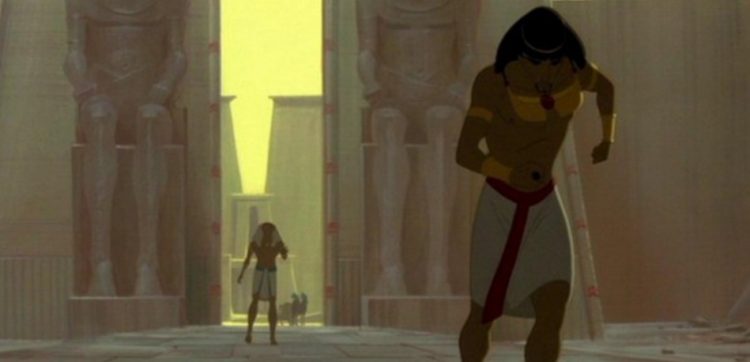1998’s The Prince of Egypt has become one of the greatest animated movies from DreamWorks Animation. It would be the company’s second feature film, and it is based on the Biblical Book of Exodus.
At the center of the story lies Moses. He goes from being a Prince in Egypt to leading one of the world’s largest documented exodus. The movie was a success at the box office with a budget of $70 million and going on to gross $218.6 million.
Besides its evergreen soundtrack, the story of Moses resonates with three of the largest religions in the world—Judaism, Christianity, and Islam. It’s also one of the best religion-based films in Hollywood.
We look at some of the movie’s inspirational scenes and why they’ve remained iconic after two decades.
The Birth of Moses

Credit: The Prince of Egypt
The animated film begins around the birth of Moses, with his people being slaves in ancient Egypt. The story’s background has the current Egyptian King, Pharaoh Seti, afraid that the Hebrew slaves would one day outnumber the Egyptians. To protect his people and their ancestral lands, he undertakes the gruesome killing of Hebrew infants at birth.
Moses was born at a time when he and other Hebrew-born sons threatened the powers of Egypt. Refusing to let her son be killed, his mother brings him and his older siblings (Miriam and Aaron) to the Nile River. She places the baby in a basket and lets it drift away. Then, broken and in pain, she sings a final lullaby to the floating baby, hopeful that someone will find him and save him.
A Watchful Sister, A New Mother and Brother

Credit: The Prince of Egypt
The baby’s elder sister, Miriam, refuses to let go and follows the floating basket to see what might become of it. By happenstance, Pharaoh’s wife, Queen Tuya, was also at the bank of the Nile River. Miriam sees Queen Tuya pick up the child from the floating basket and names him Moses.
She introduces her new adopted son, Moses, to her toddler son, Rameses. Having confirmed the final destination and whereabouts of her baby brother, Miriam prays that Moses would one day grow up and be able to set his true people (the Hebrews) free.
Moses and Rameses grew up as brothers and best friends. They were particularly known for their healthy rivalry and nuisances in the streets of Egypt.
Moses Flees Egypt

Credit: The Prince of Egypt
Moses accidentally reunites with Miriam and Aaron, who informs him of his past. Refusing to believe, Pharaoh confirmed the infanticide years ago.
With a new softheartedness for the children of Israel, he comes across an Egyptian guard flogging an older Hebrew man. By accident, he pushes the Egyptian guard to his death. Rameses promises to fix things, but Moses is afraid of his actions and flees Egypt.
Moses Encounters the Burning Bush

Credit: The Prince of Egypt
As a shepherd in the house of Jethro, Moses sees a burning bush up in the mountain while taking the animals to feed. God instructs Moses to return to Egypt and free the Hebrews. God also empowers his staff to perform wonders before Pharaoh. Moses’ wife, Zipporah, chooses to go down to Egypt with him.
The Ten Plagues of Egypt

Credit: The Prince of Egypt
Rameses, now Pharaoh, is more than happy to have his brother Moses back in Egypt. However, Moses’ request to set the Hebrews free threatens the lives and existence of the Egyptians. Rameses refuses to jeopardize the life of his people for Moses and is annoyed it is the only reason Moses chooses to return to him and Egypt.
The God of the Hebrews unleashes 9 different plagues on the Egyptians. Still, Pharaoh refused to let them go.
The Passover & Last Plague

Credit: The Prince of Egypt
Moses informs the Hebrews of God’s plans for the last plague—all Egyptian firstborn sons will die. The Hebrews celebrate the first Passover in thanksgiving for being spared from death.
The death of Rameses’ son and heir emotionally breaks him, and he decides to let the Hebrews go. The Hebrews leave Egypt after years in slavery with the When You Believe song, hopeful for a better tomorrow.
The Parting of the Red Sea

Credit: The Prince of Egypt
When the Hebrews arrive at the Red Sea, they discover the Egyptians are in hot pursuit. Rameses is done mourning and, in vengeance, vows to bring the Hebrews back as slaves or kill them in the desert.
With a pillar of fire preventing the Egyptian army from reaching the gathering of Hebrews and the bank of the Red Sea, Moses stretches his staff and strikes the Red Sea with it. Dry land miraculously appears as the Hebrews march on to escape the Egyptians.
With the pillar of fire removed, the Egyptian army pursued the Hebrews through the parted Red Sea. Finally, the seawater walls collapse and kill the Egyptian army, except Rameses. Moses and Rameses bid an emotional farewell to each other from opposite sides of the Red Sea.
 Follow Us
Follow Us





